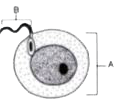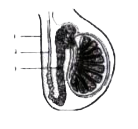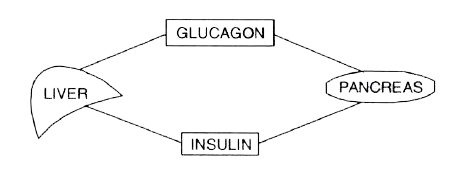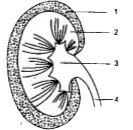A student prepared a temporary mount of a leaf peel and observed some green dots.
(i) Name these green dots and name the pigment present in them.
(ii) State the function of this pigment.
Step-by-Step Solution:
1. Observation: The student prepared a temporary mount of a leaf peel and observed some green dots.
2. Identification of Green Dots: The green dots observed in the leaf peel are called chloroplasts.
3. Pigment Present: The pigment present in these chloroplasts is known as chlorophyll.
(ii) Function of Chlorophyll:
1. Function Explanation: The primary function of chlorophyll is to trap sunlight.
2. Role in Photosynthesis: Chlorophyll is essential for the process of photosynthesis, where it helps in the synthesis of food (glucose) for the plant by converting solar energy into chemical energy.
Final Answers:
(i) The green dots are called chloroplasts, and the pigment present in them is chlorophyll.
(ii) The function of chlorophyll is to trap sunlight for the synthesis of food through the process of photosynthesis.
---
2. Identification of Green Dots: The green dots observed in the leaf peel are called chloroplasts.
(i) The green dots are called chloroplasts, and the pigment present in them is chlorophyll.
(ii) The function of chlorophyll is to trap sunlight for the synthesis of food through the process of photosynthesis.
Similar Questions
List the steps of preparation of temporary mount of a leaf peel to observe stomata.
View SolutionA student is observing the temporary mount of a leaf peel under a microscope. Draw labelled diagram of the structure (of stomata) as seen under the microscope.
View SolutionThe diagram given below represents two reproductive cells A and B. Study the same and then answer the questions that follow:

(i) Identify the reproductive cells A and B.
(ii) Name the specific part of the reproductive system where the above cells are produced
(iii) Where in the female reproductive system do these cells unite ?
(iv) Name the main hormones secreted by the (1) ovary (2) testes.
(v) Name an accessory gland found in the male reproductive system and state the function of its secretion.
View SolutionThe diagram shown below is the longitudinal section of a testis of man. Study it carefully and answer the questions that follow :

(i) Label the parts numbered 1 to 3 in the diagram.
(ii) In which part of the testis are the sperms ?
(iii) State the functions of the parts labelled 1 and 3 in the diagram.
(iv) Name the cells that secrete Testosterone.
(v) Draw a neat, labelled diagram of a sperm.
View SolutionGiven below is the outline of the cross-section of the male reproductive system :

(i) Copy the outline on to your answer sheet with pencil and label the following parts testis, epididymis, seminal vesicles, vas deferens
(ii) Name the hormone produced by the testis.
(iii) Why are sperms produced in large numbers?
(iv) State the function of the seminal vesicles.
View SolutionStudy the diagram given below and then answer the questions that follow:

(I) Name the cells of the pancreas that produce (a) glucagon (b) insulin.
(ii) State the main function of (a) glucagon (b) insulin.
(iii) Why is the pancreas referred to as an exo- endocrine gland ?
(iv) Why Is insulin not given orally but is injected into the body ?
(vj What is the technical term for the cells of the pancreas that produce endocrine hormones?
(vi) Where in the body is the pancreas located?
View SolutionName the plastid and pigment likely to be found in the cells of :
skin of green mango
View SolutionA student puts his pencil into an empty trough and observes the pencil from the position as indicated in Figure.

(i) What change will be observed in the appearance of the pencil when water is poured into the trough?
(ii) Name the phenomenon which accounts for the above stated observation.
(iii) Complete the diagram showing how the student's eye sees the pencil through water.
View SolutionThe diagram given below shows a section of a human kidney. Study the diagram carefully and answer the questions that follow:

(i) Label the parts numbered 1 to 4.
(ii) Why does part "2" have a striped appearance?
(iii)What is the fluid that passes down part:'4' ? Name the main nitrogenous waste present in it.
(iv) Mention the structural and functional unit of kidneys.
(v) Name the two major steps in the formation of the fluid mentioned
View SolutionName the following:
The pigment which gives green colour to the leaves.
View Solution
